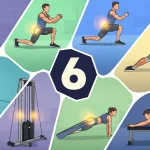What kind of exercise is light but has a huge impact? Ever heard that line? Well, Kegel exercises are a prime example.
While the movements might not look like push-ups or squats, their effects can be deeply felt, especially for pelvic health and your overall quality of life.
We often focus on training our abs, arms, or thighs at the gym. But what about the pelvic floor muscles? These muscles aren’t visible, yet their role is vital – from controlling urination, supporting important organs, to enhancing sexual satisfaction. Unfortunately, many only realize their importance when their function starts to falter.
Let’s dive deep into Kegel exercises, from their benefits to how to do them correctly!
What is Kegel Exercise?
Kegel exercise is a simple exercise designed to strengthen the pelvic floor muscles. These are the muscles that support the bladder, uterus (in women), prostate (in men), and large intestine.
Who can (and should) do Kegel exercises? The answer is: everyone, especially:
- Pregnant women or those post-childbirth
- Men undergoing prostate treatment
- Seniors experiencing urinary leakage
- Anyone who wants to improve pelvic muscle control
Benefits of Kegel Exercise: More Than Just Preventing “Pee Leaks”
You might have heard that Kegel exercises can help with “bladder leaks” or difficulty holding pee. That’s true, but the benefits extend much further:
- Prevents and treats urinary incontinence
- Accelerates postpartum recovery
- Improves sexual function and orgasm
- Prevents pelvic organ prolapse
- Helps men control ejaculation and improves erectile dysfunction
How to Find the Correct Pelvic Floor Muscles
Before starting the exercises, it’s super important to know which muscles you need to contract. The easiest way is to imagine you’re trying to stop yourself from peeing midstream.
The muscles you use to hold it in, those are your pelvic floor muscles. But remember, this is just an initial test. Don’t actually make a habit of stopping urination midway, as it can interfere with bladder health.
How to Do Kegel Exercise Correctly
Here are the steps for safe and effective Kegel exercises:
- Choose a comfortable position: You can sit, stand, or lie down.
- Contract your pelvic floor muscles (as if you’re trying to stop urine/gas).
- Hold for 3–5 seconds, then relax for 3–5 seconds.
- Repeat 10–15 times, and do 3 sessions per day.
Some things to avoid:
- Don’t hold your breath.
- Don’t contract your abdominal, thigh, or buttock muscles.
- Focus solely on your pelvic muscles.
Common Mistakes Often Made
Unbeknownst to them, many people do Kegel exercises incorrectly, for example:
- Exercising while urinating daily (this can actually be harmful)
- Contracting other muscles (making it look like you’re doing a plank)
- Inconsistency (doing it once or twice then forgetting)
Remember, even though the movements are small and invisible, quality is more important than quantity.
When Will You Feel the Results?
With correct and consistent practice, you can start to feel the benefits within 4–6 weeks.
Some may even feel it sooner, depending on their prior muscle condition and how diligently they train. But this isn’t a race. Kegel exercise is part of a long-term lifestyle.
Tips for Consistent Kegel Practice
To make sure you don’t forget, try doing them when:
- Brushing your teeth
- Sitting on public transport
- Waiting for a film’s loading screen
- Or while sitting at your computer for work
Use a reminder app or small notes on your phone. A little bit routinely yields much more tangible results.
When to Consult a Professional?
You should consult a physical therapist or doctor if:
- You’re unsure if you’re doing the movements correctly.
- There’s no improvement despite consistent practice.
- You experience pain, tension, or signs of organ prolapse.
They can guide you toward more personalized and targeted exercises.
Conclusion: Start with Simple Movements, Feel Big Changes
Kegel exercises might not make you sweat profusely. But precisely because of that, this exercise is often overlooked. Yet, its effects are immense for your quality of life, both physically and emotionally.
So, if today you can spare 5 minutes for scrolling social media, you can also start your Kegel practice. Start now. Small movements, big benefits.





